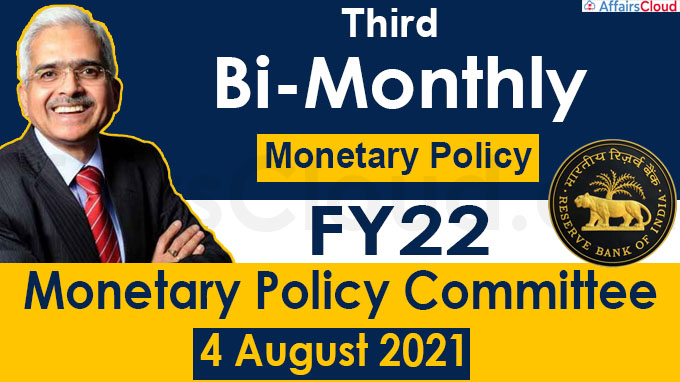 The Reserve Bank of India’s (RBI) 6-members Monetary Policy Committee (MPC) had met on 4th, 5th and 6th August 2021 and released its third bi-monthly monetary policy statement for FY22 (April 2021 – March 2022).
The Reserve Bank of India’s (RBI) 6-members Monetary Policy Committee (MPC) had met on 4th, 5th and 6th August 2021 and released its third bi-monthly monetary policy statement for FY22 (April 2021 – March 2022).
Policy Rates:
RBI decided to keep the rates unchanged for the 7th consecutive time. The unchanged Policy rates are as follows:
| Category | Rates |
|---|---|
| Policy Rates | |
| Policy Repo Rate | 4.00% |
| Reverse Repo Rate | 3.35% |
| Marginal Standing Facility (MSF) Rate | 4.25% |
| Bank Rate | 4.25% |
| Reserve Ratios | |
| Cash Reserve Ratio (CRR) | 4.00% |
| Statutory Liquidity Ratio (SLR) | 18.00% |
a.MPC’s Assessments on growth and inflation:
-Growth
The MPC has retained India’s real gross domestic product (GDP) growth projection for FY22 at 9.5 percent with 21.4 percent in Q1; 7.3 percent in Q2; 6.3 percent in Q3; and 6.1 percent in Q4.
- Real GDP growth for Q1 FY23 is projected at 17.2 percent.
-Inflation
i.Consumer Price Index (CPI) inflation was projected at 5.7 percent in FY22, with 5.9 percent in Q2; 5.3percent in Q3; and 5.8 percent in Q4.
- CPI inflation for Q1 FY23 was projected at 5.1 percent.
ii.The government retained the inflation target at 4 percent with the lower and upper tolerance levels of 2 percent and 6 percent, i.e. within a band of +/- 2 percent.
Members of MPC:
The MPC meeting was headed by RBI Governor Shaktikanta Das the other 5 members of the committee include,
- Shashanka Bhide, Ashima Goyal, Prof. Jayanth R. Varma, Mridul K. Saggar, and Michael Debabrata Patra
b.MPC’ Liquidity Measures:
-RBI extended the deadline for TLTRO on Tap Scheme
RBI has extended the Targeted Long Term Repo Operations (TLTRO) on Tap Scheme by a period of three months, i.e., till December 31, 2021. Earlier in April 2021, the scheme was made available till September 30, 2021.
i.Background: On October 9, 2020, RBI announced the TLTRO on Tap Scheme worth Rs 1 trillion to provide liquidity support to various sectors and banks
ii.Eligible Sectors under TLTRO on Tap Scheme:
- The different sectors under the scheme include Agriculture, Agri-Infrastructure, Secured Retail, Micro, Small and Medium Enterprises (MSMEs) and Drugs, Pharmaceuticals and Healthcare, 26 stressed sectors (identified by Kamath Committee) and bank lending to NBFCs.
- The liquidity availed by banks under the TLTRO scheme will be deployed only in corporate bonds, commercial paper, and non-convertible debentures issued by entities in the above sectors.
- Investments made by banks under this facility were classified as Held to Maturity (HTM) even above the 25 percent of total investment permitted to be included in the HTM portfolio.
-RBI Extended MSF for Banks till December 2021
To enable the banks to meet their Liquidity Coverage Ratio (LCR) requirements, RBI extended the Marginal Standing Facility (MSF) relaxation for 3 months, i.e., up to December 31, 2021(earlier it was extended till September 30, 2021).
- This will provide access to funds to the extent of Rs 1.62 lakh crore, and qualifies as high-quality liquid assets (HQLA) for the LCR
Background: In March 2020, RBI allowed banks to borrow overnight under MSF at their discretion by dipping into the Statutory Liquidity Ratio (SLR) up to 3 percent of net demand and time liabilities (NDTL).
SLR: It is a minimum percentage of deposits that a commercial bank has to maintain in the form of liquid cash, gold or other (state/centre) securities.
-RBI to undertake Rs 50,000 crore Auction under G-SAP 2.0
RBI decided to conduct 2 auctions of Rs 25,000 crore each (overall Rs 50,000 crore) on August 12 and 26, 2021, under G-SAP 2.0 (G-sec Acquisition Programme). RBI will also undertake regular OMOs (Open Market Operations) and operation twist (OT).
OMO:
- It is the sale and purchase of government securities and treasury bills by the RBI to regulate the money supply in the economy.
- When the RBI wants to increase the money supply in the economy, it purchases the government securities (G-Secs) from the market and sells them to suck out liquidity.
c.MPC’ Regulatory Measures
-RBI Amended LIBOR transition Guidelines
In July 2021, RBI issued an advisory to banks and other RBI-regulated entities to prepare for the transition from the international benchmark reference rate, ‘London Interbank Offered Rate’ (LIBOR) to any other widely accepted Alternate Reference Rates (ARR) by December 31, 2021. Click here to more
i.Export Credit in Foreign Currency:
- Earlier RBI has allowed authorized dealers to extend Pre-Shipment Credit in Foreign Currency (PCFC) at LIBOR / EURO-LIBOR / EURIBOR related rates of interest.
- Now due to its exit within December 2021, RBI has amended the rules and permitted banks to extend PCFC to exporters prior to shipment with widely accepted ARRs
ii.Restructuring of derivative contracts:
- Earlier RBI has treated change in any of the parameters of the original derivative contracts as a restructuring.
- Now, RBI allowed the change in those contracts for the transition from LIBOR to ARRs, RBI will not treat it as restructuring.
-RBI to Conduct 4 VRRR Auctions to Absorb Surplus Liquidity
RBI plans to conduct 4 – fortnight (14 days) Variable Rate Reverse Repo (VRRR) auctions of Rs 2.5 lakh crore on August 13, 2021; Rs 3.0 lakh crore on August 27, 2021; Rs 3.5 lakh crore on September 9, 2021; and Rs 4.0 lakh crore on September 24, 2021, to absorb surplus liquidity.
- RBI expects the amount absorbed under the fixed-rate reverse repo to remain more than Rs 4.0 lakh crore at the end of September 2021.
Background:
i.RBI has been conducting 14-day VRRR auctions as its main liquidity operation, as per the revised liquidity management framework, introduced by it in February 2020.
ii.Due to COVID-19, VRRR was suspended temporarily and re-introduced from January 2021 with initial absorption of Rs 2 lakh crore.
-RBI Postponed the Deadline to achieve Resolution Framework 1.0
RBI has postponed the Deadline for achieving 4 Financial Parameters relate to the operational performance of the borrowing entities under the Resolution Framework 1.0 viz, Total Debt to EBITDA (Earnings Before Interest, Taxes, Depreciation, and Amortization) ratio (Total Debt/EBITDA), Current Ratio, Debt Service Coverage Ratio and Average Debt Service Coverage Ratio from March 31, 2022, to October 1, 2022.
- The deadline for the parameter, Total Outside Liabilities/Adjusted Total Net Worth (TOL/ATNW) was unchanged i.e March 31, 2022.
Recent Related News:
On June 30, 2021, the RBI released the ‘Sources of Variation in Foreign Exchange(Forex) Reserves in India during 2020-21’ and reported an increase in the forex reserves in nominal terms, including the valuation effects, by USD 99.2 billion in FY21, compared to USD 64.9 billion of FY20.
On July 1, 2021, The RBI reported the Government of India’s(GoI) approval for the extension of the ‘Interest Equalization Scheme for Pre and Post Shipment Rupee Export Credit’ for 3 months, i.e., up to September 30, 2021.
About Reserve Bank of India(RBI):
Establishment – 1st April 1935
Headquarters – Mumbai, Maharashtra
Governor – Shaktikanta Das
Deputy Governors – Mahesh Kumar Jain, Michael Debabrata Patra, and M Rajeshwar Rao, T. Rabi Sankar




